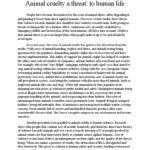In the verdant landscapes of South Carolina, a stark juxtaposition exists between idyllic pastures and the dark reality of animal cruelty. The state’s laws regarding the treatment of animals have evolved, much like the slow march of a river carving its path through the earth, shaped by a myriad of influences—cultural, societal, and legislative. Understanding these laws is vital for anyone committed to safeguarding the rights and welfare of our vulnerable companions.
At its core, South Carolina’s animal cruelty statute is designed to protect animals from needless suffering and mistreatment. The law defines animal cruelty broadly, encompassing acts of neglect, abuse, and exploitation. It crafts a compassionate framework establishing what is permissible and, more importantly, what is not. In essence, it acts as a moral compass in a world that often veers into treachery.
The South Carolina Code of Laws Title 47, Chapter 1 delineates the state’s stance on animal welfare. Within this legislative discourse, “cruelty” is articulated as any act that causes unjustifiable pain, suffering, or death to an animal. This encompasses a plethora of behaviors, such as beating, mutilating, poisoning, or otherwise inflicting harm upon an animal, be it a cherished pet or livestock raised for consumption. This wide net casts a vigilant eye over diverse species, embodying the belief that all sentient beings have an intrinsic right to exist free from harm.
Of particular interest is the concept of “neglect,” where an owner or caretaker fails to provide basic necessities, such as adequate food, water, shelter, and medical care. Neglect serves as insidious as the tide: often slipping past threshold awareness until it becomes a deluge of suffering. This aspect of the law acknowledges the importance of not just direct abuse but also the lapses in responsibility that lead to degradation of an animal’s well-being.
In South Carolina, the penalties for animal cruelty are commensurate with the severity of the offense. Misdemeanors may result in fines, community service, or imprisonment, while egregious acts can be classified as felonies, subject to harsher penalties. This legal architecture reflects the state’s resolve to deter potential offenders while offering rehabilitative opportunities for those willing to mend their ways—a strategy akin to pruning a tree to encourage healthier growth.
It is important to note the role that law enforcement and humane societies play in enforcing these statutes. Animal control officers and the South Carolina Law Enforcement Division (SLED) work hand-in-hand with local shelters and rescue organizations to investigate reports of cruelty. They are the vanguards of the law, dedicated to ensuring that the echoes of suffering do not fall on deaf ears. Their vigilance often conduces to the rescue of animals who have been subjected to horrific conditions, providing them a second chance at life.
Educational outreach is another critical component of combatting animal cruelty. South Carolina has made strides to foster awareness and understanding of responsible pet ownership and humane treatment of animals. Schools, community events, and social media campaigns disseminate knowledge and encourage empathy toward all living beings. Much like planting seeds in fertile soil, these efforts can yield a cultural shift towards compassion that will blossom over time.
Interestingly, the law also addresses the grey area around animal fighting. South Carolina prohibits dogfighting and cockfighting, earning the state a reputation for being firm against these brutal spectacles of violence. Yet, there remains a cultural challenge in eradicating the underground networks that perpetuate these barbaric practices, akin to a game of whack-a-mole where striking down one opponent prompts another to emerge.
Furthermore, South Carolina’s animal cruelty laws extend into the realm of wildlife protection. The state actively enforces regulations preventing the abuse and exploitation of wild animals, demonstrating a recognition of the intrinsic value of all creatures, regardless of domestication. This aspect transcends mere legal obligation; it reflects an acknowledgment of the interconnectedness of ecosystems and the plight of animals living in their natural habitats.
Despite these laudable efforts, the journey toward eliminating animal cruelty in South Carolina is far from complete. Advocacy groups and activists are continually rallying for stronger protections, often working to amend existing laws to bridge gaps in animal welfare. Their advocacy serves as a reminder that laws alone do not foster a culture of compassion; it requires the collective effort of society to change hearts and minds.
In conclusion, the landscape of animal cruelty laws in South Carolina is multifaceted and layered, echoing the complexities of human-animal relationships. While the legislative framework lays the groundwork for ethical treatment, it is the responsibility of individuals and communities to cultivate kindness and empathy in everyday actions. Just as a single drop can create ripples across a vast expanse of water, every act of compassion can impact the world of animals in profound ways. As South Carolinians, the charge lies with us to nurture a state where the verdant pastures are truly safe havens for all creatures, great and small, embodying a sanctuary of hope and compassion.







